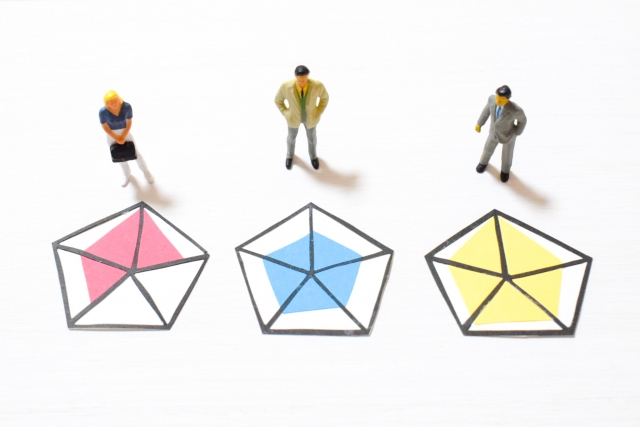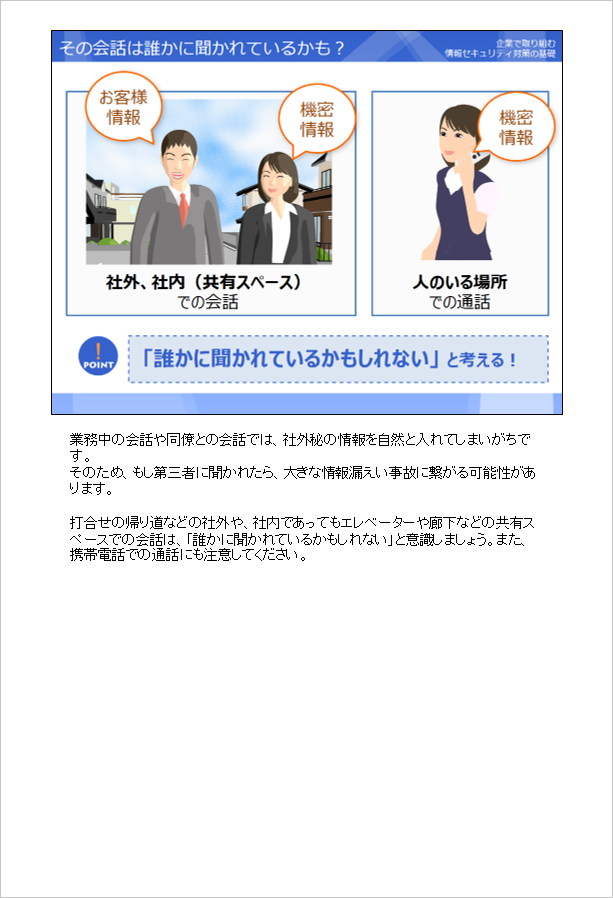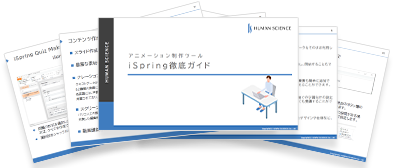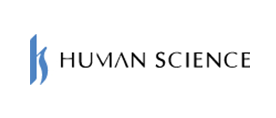2020.12.04
2025.06.27
How to Create e-Learning Materials ① ~Explaining the Importance of Material Selection, How to Obtain Them, and the Advantages and Disadvantages of Each Type~
When you are involved in creating e-learning materials for the first time, it is common to face concerns such as "Where should I start?" and "What kind of materials should I choose?"
Selecting materials is a crucial step that directly affects learning effectiveness and learner satisfaction. In this blog, we will clearly introduce the basic concepts you should know when choosing e-learning materials, how to obtain them, and the advantages and disadvantages of each method.

1. The "System" and "Materials" Required for e-Learning

E-learning refers to learning conducted using devices such as personal computers or smartphones, through the internet or other means. To implement e-learning, a delivery "system" and "teaching materials" as content are required.
The system for delivering e-learning is called an LMS (Learning Management System).*
When equipped with an LMS, you can do the following:
- ・Issue IDs for each learner and record individual histories
- ・Assignment of materials by learner type (for administrators, for technical positions, etc.)
- ・Management of learning status by teaching materials (study time, test scores, etc.)
- ・Setting the Learning Period
- ・Acquisition of statistical data such as participation rate, study time, and correct answer rate
*Currently, the mainstream is shifting towards a "Talent Management System" that is managed in conjunction with HR information, rather than an LMS specialized for education.
However, an LMS is not required to implement e-learning. Implementing an LMS involves both cost and time.
If there is urgency in conducting training or if you want to start e-learning simply, there are methods that do not involve an LMS.
While it becomes difficult to obtain learning history, if you place educational materials on a shared server within the company or group, or on the company's internal portal site, online learning is possible.
Alternatively, you can create and distribute DVDs, etc.
2. Why Choosing e-Learning Materials is Important
When introducing e-learning, it is not enough to simply prepare content; if you do not select the most suitable materials for your company, there may be cases where sufficient learning effectiveness cannot be achieved. Here, we explain the importance of choosing materials and the key points for selection.
〈Reasons Why Selecting e-Learning Materials is Important〉
・If the selection is wrong, the educational objectives cannot be achieved, and no effect will be obtained
If the content of the teaching materials deviates from your company's issues and objectives, no matter how much you study, it will not lead to results. For example, if you are required to learn specific know-how but choose materials that are abstract and not linked to practical work, it is meaningless. In other words, if you make a mistake in selecting teaching materials, there is a risk that the very purpose of education will not be fulfilled.
・Learners' motivation is influenced by the type and quality of teaching materials
Even with the same learning theme, the learner's impression can vary greatly depending on the structure and presentation style of the materials. Materials that utilize videos and diagrams are easier to understand and help boost learning motivation, whereas boring materials filled only with text fail to maintain learners' interest for long. Choose materials with the learner's perspective in mind, such as "easy to understand" and "user-friendly."
* In cases where learners have very high motivation, simple materials without unnecessary embellishments may be optimal. At Human Science, we recommend tailoring the presentation style and structure according to the learner's situation and the content of the materials.
〈Points for Selecting e-Learning Materials〉

・Clearly identify what kind of training materials are needed for your company's challenges
The first step is to clarify what your company aims to achieve through education and what issues you want to resolve. Let's outline specific goals such as "teaching business manners to new employees" or "raising awareness of information security."
・Carefully consider the purpose, participant needs, budget, and other factors
When selecting teaching materials, also take the following points into account and compare options to find the best fit for your company.
・Level and needs of the target participants: for new employees or for managers, etc.
・Budget considerations: one-time purchase or subscription model, etc.
・Compatibility with the company's e-learning environment: support for LMS (Learning Management System), etc.
Choosing teaching materials is a strategic decision that affects the quality of learning. Accurately assess your company's goals and the learners' needs to select the most suitable materials. This is the key to maximizing learning effectiveness.
3. Four Ways to Obtain e-Learning Materials

E-learning materials can be obtained in various ways depending on the purpose, budget, and speed of implementation. Here, we explain the characteristics, advantages, and disadvantages of four representative methods.
〈How to Obtain.1〉Purchase Ready-made Teaching Materials
The biggest advantage of commercially available ready-made e-learning materials is that you can purchase already completed content and use it easily. They are especially expected to be useful in general fields that are less affected by the type of business, such as compliance, information security, and business manners.
◯Merits
・Fast implementation speed
・Quality is stable because it is supervised by professionals
・Relatively low cost (sometimes with flat-rate or volume discounts)
●Disadvantages
・May not match the unique circumstances or business content of the company
・Content may be too general or abstract for learners
〈How to Obtain.2〉Customize Ready-made Teaching Materials
This method customizes parts of ready-made teaching materials to suit your company. While covering some aspects with existing materials, you add or modify information to create teaching materials aligned with your company's objectives.
It is possible to flexibly adjust by integrating multiple materials or changing case studies to actual situations that occurred within your company. This approach is suitable when "starting from scratch is difficult, but ready-made products alone are insufficient."
◯Merits
・Can be tailored to practical content suited to your company's operations
・Even if you are unsure about specialized knowledge or production skills, you can still achieve a certain level of originality
・Relatively good balance between effort and cost
●Disadvantages
・Depending on the scope of customization, costs may increase and delivery times may be delayed
・In some cases, significant changes or revisions to the teaching materials may be difficult
〈How to Obtain.3〉Order Custom-Made Teaching Materials
This is a method to order custom-made teaching materials from a vendor. A major advantage is that you can create your company's unique teaching materials from scratch with professional support. For companies that are unsure about what kind of materials to create or want to convert their own know-how into e-learning, considering custom-made materials is one option.
◯Merits
・You can freely design everything such as learning content, scenarios, and design
・Content can be tailored to fit your company's systems, culture, and business operations
●Disadvantages
・Production period tends to be long, and costs can be high
・It may take time to revise or add to the teaching materials
〈How to Obtain.4〉Create Original Teaching Materials In-House
This is a method of producing teaching materials in-house. There are two types: one where all processes are carried out internally, and another where a "teaching material creation tool" is used, with the latter being easier. Since it can be done with relatively low budget, if you have the skills and know-how to create e-learning materials within your company, you may want to consider in-house production.
◯Merits
・Production costs paid to external parties can be reduced
・Corrections and updates can be made flexibly and quickly
●Disadvantages
・Requires production skills and time resources
・May lack objectivity and expertise in content
There are various ways to obtain e-learning materials. For general learning content, ready-made products are suitable, while for content tailored to business operations, custom-made or in-house production is recommended. We suggest considering these options flexibly according to your company's situation.
Related Columns: How to Prepare e-Learning Materials? Explanation of How to Obtain and Key Points for Creating Excellent Materials!
4. Formats of Teaching Materials and Suitable Subjects

Next, we will introduce the formats and suitable subjects you should know when choosing teaching materials.
There are various formats of teaching materials.
They range from very simple ones, such as paper texts converted directly into PDF format, to rich ones featuring characters appearing with elaborate animations, to those requiring learners to perform operations like clicking or dragging, and even those composed of live-action videos.
There are three types of materials that we often assist in producing.
- 1) Animation (HTML5 format)
- 2) Video Formats
- 3) PowerPoint, PDF
Each format has its own advantages and disadvantages, and there are topics that are better suited for each expression.
Let's take a look at the characteristics of each.
1) Animation (HTML5 format)
| Features | Animated format materials. Explanation using illustrations and animations. Participants can also perform operations within the materials (quizzes, pop-up displays, simulations). |
|---|---|
| Representative Software | AnimateCC, iSpring, Articulate Storyline, etc. |
| Benefits | ・Able to create rich content that is expressive, aids understanding, and strongly motivates learning ・Can express matters that are difficult to present in live-action |
| Disadvantages | There is a strong tendency for labor and costs to increase. |
| Suitable Themes | Explanations of business skills, analytical methods, screen operation procedures, and the mechanisms of machines |
| Example of Teaching Materials | • Business procedures spanning multiple departments • Case studies of incidents • NG examples related to harassment • Mechanisms and movements of machines such as car engines • Screen operations of business systems (simulation) |
Related Column: How to Create e-Learning Materials ② - Animation Edition
Related Column: What is iSpring Suite? Features, Pricing, and Benefits of Implementation
Create Rich e-Learning Materials with Familiar PowerPoint - iSpring Implementation Support
2) Video Formats
| Features | Edit videos shot with camcorders or smartphones. In addition to the footage, create by adding subtitles or captions to supplement the explanations. |
|---|---|
| Representative Software | Adobe Premiere Pro, Final Cut Pro, etc. |
| Benefits | Due to the video file format, it can be used on various devices such as computers and smartphones during learning. |
| Disadvantages | ・Correction requires shooting, making it difficult to make changes easily ・There is a strong tendency for file sizes to increase (high load on communication lines, delays in playback are likely to occur) |
| Suitable Themes | It is often easier to understand by seeing the actual object than by explaining it with words. |
| Example of Teaching Materials | ・How to operate equipment (especially complex operating procedures) ・How to use tools during construction ・Documenting and creating teaching materials from technical training conducted in group training |
3) PowerPoint, PDF

| Features | Use files in PowerPoint format and PDF format as e-learning materials. There are cases where existing materials are used as is, and cases where they are restructured based on existing materials (such as adding explanatory text or narration for content explained orally). |
|---|---|
| Representative Software | Microsoft PowerPoint, Adobe Acrobat, iSpring, etc. |
| Benefits | ・Easy to handle ・Easy to modify ・Short production time leads to quick delivery ・Often low cost and effort required |
| Disadvantages | Depending on the motivation of the participants, the completion rate and understanding may be low. |
| Suitable Themes | ・High frequency of updates ・Materials prioritized by time and cost ・Items to be utilized as technical information and manuals |
| Example of Teaching Materials | Educational materials with high update frequency, such as legal-related content Quickly disseminating explanations of rules and relatively simple business procedures Essential knowledge and manuals for business (in cases where a dictionary-like usage is expected) |
5. How to Utilize Existing Internal Documents

If you already have PowerPoint files or PDF files as internal materials, we can create teaching materials in various formats based on them.
As mentioned above, depending on the theme of the materials, there are suitable and unsuitable formats, but here are some images of each.
To create an animation format, you can visualize the information presented in text on PowerPoint or PDF, add illustrations, and apply animation effects.
You can also design navigation characters to add a friendly touch.
Additionally, you can create narration that matches the animation, resulting in richer content.
To create video formats, we will actually film the items explained in existing materials and capture the appearance of the instructor providing explanations, followed by editing.
However, for this type of teaching material, we can only accommodate themes that can be filmed or if the instructor can be made available.
When filming the instructor, it is also possible to composite slides such as PowerPoint with the instructor's appearance on screen.
You can reuse existing materials as they are to create PowerPoint and PDF formats. In doing so, correcting unclear parts or areas where the text is too small for on-screen viewing as e-learning can make the materials easier to learn. It is also possible to utilize PowerPoint animation effects or add narration.
Author:
Shizuko Sase
Education Solutions Department Production Group Writer
After joining Human Science, worked as a technical writer,
gaining experience in the design and writing of product manuals and business manuals.
Subsequently engaged in writing and production direction of e-learning materials.
Involved in the production of approximately 200 educational materials so far.
Contact Information:
Phone Number: 03-5321-3111
hsweb_inquiry@science.co.jp
No Failures!
Key Points for Creating e-Learning Manuscripts
We will focus on the parts of the documents that have already been created, such as materials used in group training, and explain the points to note and areas for revision.

[Content]
- Let's check the workflow.
- Let's brush up the slides.
① Classify and label the information
② Organize and layout the information
③ Brush up
Understand the Features and Usage of iSpring Suite / iSpring Suite AI!Comprehensive iSpring Guide

This section introduces the overview and usage of the animation teaching material production tool "iSpring."
This book provides a complete understanding of iSpring. You will also have an image of the teaching material production after implementation.
【Contents】
- What is iSpring Suite / iSpring Suite AI
- How to create teaching materials using iSpring Suite / iSpring Suite AI
- Overview and utilization of iSpring Suite AI
- Features of iSpring Suite AI
- Specific Usage of iSpring Suite AI
- iSpring Suite AI Certified Resellers
- Introduction to Human Science














